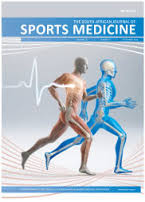Rugby World Cup 2019 injury surveillance study
DOI:
https://doi.org/10.17159/2078-516X/2020/v32i1a8062Abstract
Background: Full contact team sports, such as rugby union, have high incidences of injury. Injury surveillance studies underpin player welfare programmes in rugby union. Objective: To determine the incidence, severity, nature and causes of injuries sustained during the Rugby World Cup 2019.
Methods: A prospective, whole population study following the definitions and procedures recommended in the consensus statement for epidemiologic studies in rugby union. Output measures included players’ age (years), stature (cm), body mass (kg), playing position, and group-level incidence (injuries/1000 player-hours), severity (days- absence), injury burden (days absence/1000 player-hours), location (%), type (%) and inciting event (%) of injuries.
Results: Overall incidences of injury were 79.4 match injuries/1000 player-match-hours (95% CI: 67.4 to 93.6) and 1.5 training injuries/1000 player-training-hours (95% CI: 1.0 to 2.3). The overall mean severity of injury was 28.9 (95% CI: 20.0 to 37.8) days absence during matches and 14.8 (95% CI: 4.1 to 25.5) days absence during training. The most common locations and types of match injuries were head/face (22.4%), posterior thigh (12.6%), ligament sprain (21.7%) and muscle strain (20.3%); the ankle (24.0%), posterior thigh (16.0%), muscle strain (44.0%) and ligament sprain (16.0%) were the most common locations and types of injuries during training. Tackling (28.7%), collisions (16.9%) and running (16.9%) were responsible for most match injuries and non-contact (36.0%) and contact (32.0%) rugby skills activities for training injuries.
Conclusion: The incidence, severity, nature and inciting events associated with match and training injuries at Rugby World Cup 2019 were similar to those reported for Rugby World Cups 2007, 2011 and 2015.
Downloads
Downloads
Published
Issue
Section
License
The South African Journal of Sports Medicine reserves copyright of the material published. The work is licensed under a Creative Commons Attribution 4.0 (CC BY 4.0) International License. Material submitted for publication in the South African Journal of Sports Medicine is accepted provided it has not been published elsewhere. The South African Journal of Sports Medicine does not hold itself responsible for statements made by the authors.
How to Cite
- Abstract 2093
- PDF 1026





.png)